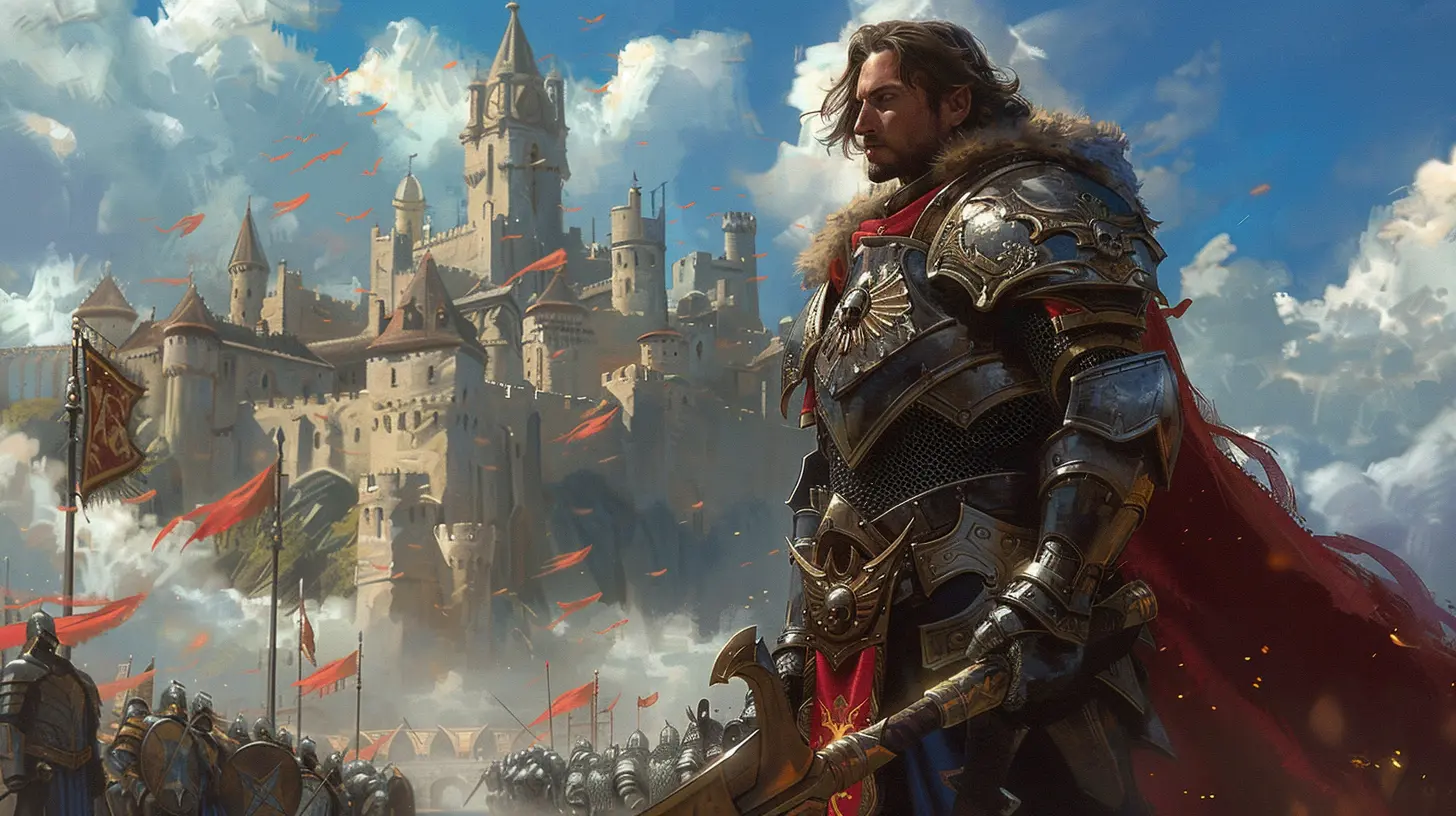How to Build the Perfect Deck in Magic: The Gathering
11 December 2024
Building a killer deck in Magic: The Gathering (MTG) can feel like assembling IKEA furniture without the instruction manual—but hey, that’s half the fun, right? Whether you're a seasoned planeswalker or a rookie who just stumbled upon their first Booster Pack, crafting a deck that shines under pressure is what separates the casual magicians from the true spell-slinging pros.
No worries, though—I’m here to walk (or, let’s be honest, stumble) through the ins and outs of the deck-building process with you. It’s a mix of strategy, creativity, and a pinch of madness. Let’s dive in and conjure up your perfect deck!
Why Your Deck Matters (A Lot)
Here’s the deal: your deck is your lifeblood in MTG. It’s your arsenal, your strategy, and, sometimes, your straight-up chaos machine. Whether you're aiming to unleash a horde of goblins, freeze your opponent’s battlefield with a blizzard of counters, or stomp through the multiverse with big, stompy creatures, your deck needs to do one thing brilliantly: work.Think of it like cooking. Sure, you can toss random ingredients into a pot and call it “stew,” but if your flavors clash (or, worse, you forget the salt), no one will want a second bite. A good deck is the same: every card should have a purpose, and the whole thing should blend together like peanut butter and jelly.
Step 1: Start With Your Win Condition
Before you start tossing cards into your imaginary shopping cart, ask yourself: How do I want to win?MTG has a million ways to nail victory. Do you want to crush your opponent with massive creatures? Drain their life total from afar? Lock them out of the game entirely (cue the evil laughter)? Your win condition is your deck’s soul. Everything else—literally everything—revolves around this.
Common Win Condition Archetypes:
1. Aggro: Go fast, hit hard. Think of it as the MTG equivalent of a sugar rush. Use cheap creatures and direct damage spells to overwhelm the opponent before they can react. Goblins and mono-red decks live in this category.2. Control: Patience is key here. You whittle down your opponent with counterspells, removal, and maybe a big finisher card to seal the deal once the dust clears.
3. Combo: You’re playing 4D chess here, assembling a specific sequence of cards to pull off a devastating, game-winning move. It’s risky, but oh-so-satisfying when it works.
4. Midrange: A bit of everything. Versatile and adaptable, these decks walk the fine line between aggression and control, relying on efficient creatures and spells to grind out wins.
Whatever you pick, keep it in the back of your mind as we build. It’ll save you from adding cards that don’t fit the vibe.
Step 2: Choose Your Colors (The MTG Pie of Doom)
MTG’s five-color system is like a buffet—but instead of mac and cheese or sushi, you’re choosing whether you want to wield fiery destruction, summon angelic armies, or just mess with reality itself. Each color has its strengths, weaknesses, and a personality all its own:- White (Order and Protection): Life gain, defensive strategies, and armies of creatures working together like a choreographed flash mob.
- Blue (Knowledge and Trickery): Counterspells, card draw, and (let’s be real) annoying your opponent into submission.
- Black (Ambition and Death): Sacrificing creatures, graveyard shenanigans, and flat-out making your opponent miserable.
- Red (Chaos and Passion): Explosions, dragons, and a “go big or go home” mantra.
- Green (Life and Growth): Big creatures, ramping mana like a pro, and stomping faces with nature on your side.
Want the best of both worlds? Mix and match! Multicolor decks open up insane possibilities, but they also come with a side of potential mana problems. Fair warning.
Step 3: Nail Down Your Mana Base
Okay, real talk: if your mana base is trash, your deck’s going to fall flat on its face. You wouldn’t set off on a road trip without gas in the tank, and you definitely shouldn’t shuffle up a deck with too few lands or the wrong color mix.Here’s a rule of thumb: for a standard 60-card deck, you want about 24 lands. But this can vary depending on your strategy. Aggro decks might get away with 20-22 lands, while control or ramp decks may need closer to 26.
Tips for a Solid Mana Base:
- Use dual lands or shocklands if you’re playing multiple colors. They’ll save you from awkward mana droughts.- Include mana-fixing cards like Cultivate, Arcane Signet, or Fabled Passage to smooth things out.
- Avoid overloading your deck with color-intensive spells (like cards that require three or more mana of a specific color) unless your mana base can handle it.
Your deck should flow like a river, not a clogged drain. Keep that in mind.
Step 4: Build Around a Core Strategy
Once you’ve locked in your win condition, colors, and mana base, it’s time to fill in the meat of your deck. Here’s the simplest framework to guide you:The 40-20 Rule:
- 40% Creatures: These are your troops—your offense, defense, and everything in between. Depending on your strategy, this might mean hordes of tiny critters, a handful of game-changing titans, or something in between.- 20% Removal/Interaction: These spells take care of enemy threats. Think board wipes, counterspells, or direct damage spells. Trust me, you don’t want to stare down a Baneslayer Angel with no way to deal with it.
- The Rest: This is your “secret sauce.” Card draw, ramp, utility spells—whatever supports your strategy and helps your deck run like a well-oiled machine.
Step 5: Test, Tweak, Repeat
Newsflash: You’re not going to build the perfect deck on your first try. And that’s okay! Testing is where the magic (pun intended) really happens.Playtesting Tips:
1. Goldfishing: Play your deck solo to see how it flows without an opponent. It’s a quick way to catch glaring issues.2. Friendly Matches: Play with your friends or at your local game store. They’ll probably point out weaknesses you didn’t even notice.
3. Fine-Tuning: Did you draw a specific card too often? Cut it down. Did you desperately need removal at a critical moment? Add more. Treat your deck like a living, breathing thing—it grows and evolves with every game.
Bonus Tips for Deck-Building Awesomeness
- Stick to 60 cards: I know it’s tempting to cram in all your favorites, but keep it lean. Every card in your deck should be pulling its weight.- Synergy is king: A bunch of great cards slapped together isn’t as strong as a cohesive strategy. Make sure your cards “talk” to each other.
- Sideboard smartly: If you’re playing tournaments, your 15-card sideboard can help counter specific matchups. Use it wisely.
- Be prepared to lose: Even the best decks struggle against certain strategies. Treat losses as learning experiences.
Have Fun!
At the end of the day, Magic: The Gathering is a game. Sure, winning feels great, but the joy of MTG lies in the creativity, the camaraderie, and the thrill of seeing your deck come to life exactly how you imagined. Don’t overthink it—just shuffle up, have fun, and enjoy the ride!all images in this post were generated using AI tools
Category:
Card GamesAuthor:

Madeleine McCaffrey
Discussion
rate this article
13 comments
Reece McCabe
Building the perfect deck is like crafting your unique story in Magic: The Gathering! Embrace your creativity, experiment boldly, and remember: every setback is just a stepping stone to your ultimate victory. Let the fun begin!
February 2, 2025 at 5:42 PM

Madeleine McCaffrey
Absolutely! Embracing creativity and learning from setbacks are key to crafting a unique and powerful deck. Let's enjoy the journey!
Anabella McAlister
Strategic synergy and adaptability are key for a winning MTG deck!
January 28, 2025 at 4:49 AM

Madeleine McCaffrey
Absolutely! Strategic synergy enhances card interactions, while adaptability allows you to adjust your strategy in various matchups. Both are essential for a powerful deck!
Lindsey McAllister
In the shadows of strategy, the perfect deck whispers secrets only the brave dare to uncover. Each card holds a tale, a hidden synergy waiting to be unleashed. What if your next draw reveals not just victory, but the key to an unseen dimension? Dare to build, and let the magic unfold.
January 24, 2025 at 4:51 PM

Madeleine McCaffrey
Thank you for your insightful comment! Indeed, every card has its own story and potential. Embracing creativity and strategy can lead to truly magical experiences in deck-building.
Pilar Newman
Great tips! Balancing strategy and fun is essential.
January 21, 2025 at 3:51 AM

Madeleine McCaffrey
Thank you! I'm glad you found the tips helpful. Striking that balance truly makes the game more enjoyable!
Poppy McMurtry
Building the perfect Magic deck is like assembling a sandwich: layer on the right cards, add a pinch of luck, and don’t forget the secret sauce of strategy! Remember, a well-crafted deck is the tastiest way to defeat your opponents!
January 16, 2025 at 6:14 PM

Madeleine McCaffrey
Absolutely! Just like a sandwich, each card adds to the flavor of your strategy. Balancing synergy, luck, and clever tactics is key to crafting a winning deck. Happy brewing!
Brianna Barron
Great tips! Building a strong deck is essential for success. Can't wait to try these strategies in my next game!
January 13, 2025 at 6:16 AM

Madeleine McCaffrey
Thanks! I'm glad you found the tips helpful. Good luck with your deck building—enjoy your next game!
Luma Hamilton
Great tips! Building a perfect deck requires a mix of strategy and creativity. It’s all about finding what resonates with you and adapting as you learn. Happy gaming!
January 7, 2025 at 5:07 PM

Madeleine McCaffrey
Thank you! I completely agree—finding your unique playstyle is key to deck-building success. Happy gaming!
Georgina McSweeney
Great article! Focusing on synergy and balance between creatures, spells, and lands is crucial for a strong Magic: The Gathering deck. Don't forget to consider your mana curve and playtesting!
January 4, 2025 at 3:46 AM

Madeleine McCaffrey
Thank you! You’re absolutely right—synergy, balance, and a solid mana curve are key to crafting a successful deck. Playtesting is essential for fine-tuning!
Sorin Elliott
Ah, yes, because we all know that building the perfect deck is as easy as pie—just toss in a few random cards and hope for the best! Genius advice, really.
December 30, 2024 at 4:40 AM

Madeleine McCaffrey
I appreciate your sarcasm! Building a great deck takes strategy and thought, and I'm here to provide tips that go beyond just random selections.
Cassian Hall
Great tips! Building a perfect deck takes strategy and creativity. I especially loved the emphasis on balancing colors and synergy—definitely helps in maximizing your chances in competitive play!
December 23, 2024 at 5:50 PM

Madeleine McCaffrey
Thank you! I'm glad you found the tips helpful. Balancing colors and synergy is indeed key to a successful deck. Happy brewing!
Hannah Dorsey
Great tips! Building a perfect deck takes creativity and strategy. Don’t forget to playtest and adjust based on your experiences. Consistent tweaking makes all the difference. Happy gaming!
December 18, 2024 at 3:43 PM

Madeleine McCaffrey
Thank you! Absolutely, playtesting is key to refining a deck and enhancing its performance. Happy deck building!
Damon Underwood
Just remember: more dragons = more fun, right?
December 13, 2024 at 3:35 PM

Madeleine McCaffrey
Absolutely! A deck with dragons can definitely add excitement and epic plays to your game! 🐉✨
Rosalyn Thompson
This article offers valuable insights into deck-building strategies in Magic: The Gathering. Emphasizing synergy, card selection, and mana balance, it highlights the importance of adaptability and understanding your playstyle. A well-crafted deck can significantly enhance competitive performance and overall enjoyment.
December 11, 2024 at 4:35 PM

Madeleine McCaffrey
Thank you for your feedback! I'm glad you found the insights on synergy, card selection, and adaptability useful in crafting a competitive deck. Happy brewing!
MORE POSTS

Creating Your Own World: Tips for Designing Epic RPG Settings

How Stealth Games Enhance Immersion through Minimalism

Most Influential Video Games in Teen Culture

Early Access Games That Redefine the RPG Experience

Card Games Inspired by Pop Culture: Movies, TV, and More

Classic Xbox Titles That Should Be on Your Radar

The Role of FOMO in Battle Pass Design

Can In-Game Purchases Ever Be Truly Fair?

Why Story-Driven Games Are Dominating the Industry